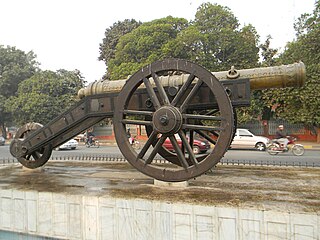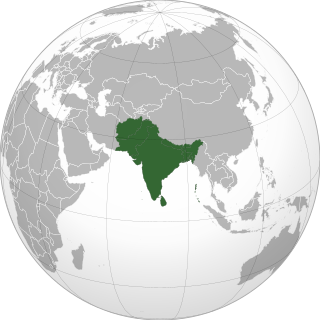
Gujrat is a city in the Punjab Province of Pakistan. It is the capital of Gujrat District and it is the 21st largest city of Pakistan by population. Along with the nearby cities of Sialkot and Gujranwala, Gujrat forms part of the Golden Triangle of industrial cities with export-oriented economies.

Jassa Singh Ramgarhia (1723–1803) was a prominent Sikh leader during the period of the Sikh Confederacy. He was the founder of the Ramgarhia Misl.

Sultan-ul-Qaum Sardar Jassa Singh Ahluwalia was a Sikh leader during the period of the Sikh Confederacy, being the Supreme Leader of the Dal Khalsa. He was also Misldar of the Ahluwalia Misl. This period was an interlude, lasting roughly from the time of the death of Banda Bahadur in 1716 to the founding of the Sikh Empire in 1801. He founded the Kapurthala State in 1772.

The Zamzama Gun also known as Kim’s Gun or Bhangianwali Toap is a large-bore cannon. It was cast in about 1757 in Lahore during the Durrani Empire. It is currently on display in front of the Lahore Museum in Lahore, Pakistan.

Sardar Charat Singh, also romanised as Charhat Singh, was the father of Mahan Singh, and the grandfather of Ranjit Singh. He distinguished himself at an early age in campaigns against Ahmad Shah Abdali and along with 150 horsemen split from the Singhpuria Misl to establish the Sukerchakia Misl.
The siege of Multan began in March 1818 and lasted until 2 June 1818 as part of the Afghan–Sikh Wars, and saw the Sikh Empire capture the city of Multan from the Durrani Empire.

The Afghan–Sikh Wars spanned from 1748 to 1839 in the Indian subcontinent, and saw multiple phases of fighting between the Durrani Empire and the Sikh Empire, mainly in and around Punjab region. The conflict's origins stemmed from the days of the Dal Khalsa, and continued after the Emirate of Kabul succeeded the Durrani Empire.
The Battle of Sialkot took place on 12 November 1763, between the Durrani Empire, led by Jahan Khan, and the Sukerchakia Misl, led by Charat Singh, as part of the Afghan-Sikh wars which concluded with Sikh victory.
The Battle of Gujranwala was fought between the Durrani Empire and the Sikh Confederacy in September 1761.

Ahmad Shah Durrani invaded India eight times between 1748 and 1767. After the assassination of Nadir Shah, Ahmad Shah Durrani succeeded the throne of Afghanistan and started plundering wealth from nearby regions. His repeated incursions brought the Mughal empire to the brink of collapse and further dealt a major blow to Maratha dominions in the North at Panipat, creating a power vacuum. His objectives were met through the raids and caused political issues in India.

The Battle of Rohtas took place somewhere in December 1779, between Timur Shah Durrani and the Bhangi Misl. Timur Shah consolidated his rule through multiple attempts, and also attempted an earlier invasion in 1775, however realizing the weakness of his army in view of smaller in number, Timur Shah retired to Peshawar which proceeded with rebellion by Faizullah Khan, who plotted to assassinate Timur Shah but was cunningly executed. In late 1779, Timur Shah decided to conquer Multan.
The Battle of Chenab was fought between the Durrani Empire and the Sikh Misls of Dal Khalsa in 1764.
The Battle of Jandiala took place in December 1764 between the Durranis and the Sikhs, during Ahmad Shah Abdali's seventh campaign into India. Ahmad Shah Abdali and his army marched towards Jandiala and as soon as they reached near the town, Sikhs opposed them and a battle took place where Afghans were defeated and the Afghan commander Rahim Khan Bakhshi was killed.

The Siege of Multan took place on 20 February 1810 as part of the Afghan-Sikh Wars, which resulted with the capture of the city of Multan by the Sikh Empire from the Durrani Empire.
The Battle of Qarawal was fought Between the Sikhs under the command of Charat Singh against the Afghan forces lead by Ahmad Shah Abdali and his Kalat ally Nasir Khan.It was the battle in which Afghan and Kalati forces were tried to defeat the Sikh misl and force them to withdraw to Amritsar.
The Battle of Gujrat took place in December 1765 between the supreme leader of the Chaj Doab territory, Sultan Muqarrab Khan, who owed allegiance to Ahmad Shah Abdali, and the Sikh Misls under Charat Singh and Gujar Singh. Muqarrab Khan was defeated in the battle, and the Sikhs captured the city. Gujar Singh made Gujrat his capital after repairing and rebuilding the fort with stronger walls.
The Battle on the Beas took place in March 1765, between the Durranis and the Sikh Misls as part of the Afghan-Sikh wars during Ahmad Shah Abdali's return home. The battle which took place on the seventh day of the ongoing harassment by the Sikhs, ended without any conclusion.
The Battle on the Sutlej took place in March 1765, between the Durranis and the Sikh Misls as part of the Afghan-Sikh wars during Ahmad Shah Abdali's return home. The pitched battle ended indecisively.
The Battle of Rohtas took place in middle of 1767 between the Durranis and the Sikh Misls. Sarfaraz Khan was appointed as the governor of Rohtas Fort by Ahmad Shah Abdali and he planned to capture Gujrat from Gujar Singh. But the plan leaked out causing Charat Singh and Gujar Singh to retaliate by capturing Rohtas which resulted with Sikh victory and imprisonment of Sarfaraz Khan.
The Gujrat Expedition from 26 April to 29 April 1797 involved a three-day battle between the Durranis and the Sikh Misls as part of the Afghan-Sikh wars which ended with Sikh victory and the killing of Afghan governor Ahmad Shah Shahanchibashi.








